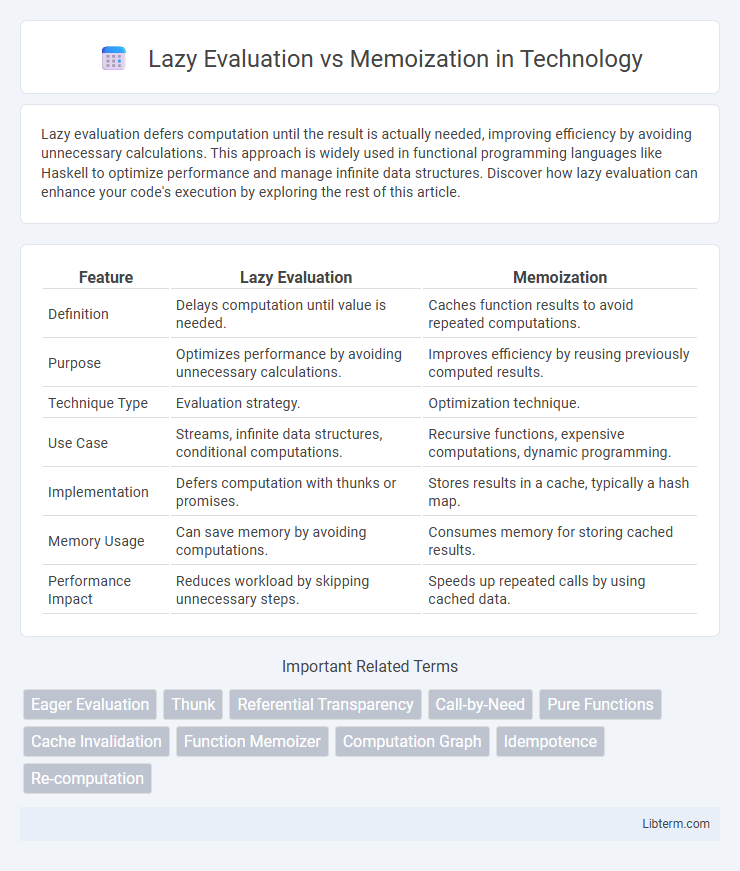Lazy evaluation defers computation until the result is actually needed, improving efficiency by avoiding unnecessary calculations. This approach is widely used in functional programming languages like Haskell to optimize performance and manage infinite data structures. Discover how lazy evaluation can enhance your code's execution by exploring the rest of this article.
Table of Comparison
| Feature | Lazy Evaluation | Memoization |
|---|---|---|
| Definition | Delays computation until value is needed. | Caches function results to avoid repeated computations. |
| Purpose | Optimizes performance by avoiding unnecessary calculations. | Improves efficiency by reusing previously computed results. |
| Technique Type | Evaluation strategy. | Optimization technique. |
| Use Case | Streams, infinite data structures, conditional computations. | Recursive functions, expensive computations, dynamic programming. |
| Implementation | Defers computation with thunks or promises. | Stores results in a cache, typically a hash map. |
| Memory Usage | Can save memory by avoiding computations. | Consumes memory for storing cached results. |
| Performance Impact | Reduces workload by skipping unnecessary steps. | Speeds up repeated calls by using cached data. |
Understanding Lazy Evaluation
Lazy evaluation defers the computation of expressions until their values are needed, optimizing performance by avoiding unnecessary calculations. This technique is widely used in functional programming languages such as Haskell, allowing for infinite data structures and improved resource management. By contrast, memoization stores the results of expensive function calls to reuse them, focusing on avoiding repeated computations rather than delaying them.
The Core Concepts of Memoization
Memoization is a technique that stores the results of expensive function calls and reuses them when the same inputs occur again, significantly improving performance by avoiding redundant calculations. Unlike lazy evaluation, which delays computation until the result is needed, memoization actively saves computed results to optimize future access. Core to memoization is the use of a cache, often implemented as a hash table or dictionary, that maps function arguments to their computed outputs, enabling constant-time retrieval for repeated calls.
Key Differences Between Lazy Evaluation and Memoization
Lazy evaluation delays the computation of an expression until its value is needed, optimizing performance by avoiding unnecessary calculations. Memoization stores the results of expensive function calls and returns the cached result when the same inputs occur again, improving efficiency by preventing redundant computations. The key difference lies in lazy evaluation's demand-driven execution versus memoization's focus on caching previously computed results.
Performance Impacts: Speed and Efficiency
Lazy evaluation delays computation until the value is needed, reducing unnecessary processing and improving performance by avoiding premature calculations. Memoization stores previously computed results, speeding up repeated function calls by retrieving cached outputs instead of recomputing them. Both techniques enhance efficiency, but lazy evaluation optimizes resource usage dynamically while memoization optimizes speed through result reuse.
Use Cases for Lazy Evaluation
Lazy evaluation is ideal for scenarios where computations are expensive and may not be needed immediately, such as processing large data streams or infinite sequences in functional programming. It helps improve performance in applications like real-time data analysis or demand-driven computation by delaying evaluation until results are required. Examples include lazy loading in user interfaces and on-demand query execution in databases to optimize resource usage.
When to Use Memoization
Memoization is most effective when dealing with expensive recursive functions or computations involving overlapping subproblems and repeated calls with the same inputs, such as in dynamic programming. It significantly improves performance by storing previously calculated results to avoid redundant calculations in algorithms like Fibonacci sequence, factorial, or pathfinding problems. Use memoization when function calls are deterministic, pure, and return consistent results for identical inputs, ensuring cached data remains valid and beneficial.
Potential Pitfalls and Limitations
Lazy evaluation can lead to memory leaks if deferred computations accumulate without being executed, causing increased space complexity. Memoization may result in excessive memory usage due to caching every computed result, which can be problematic for functions with large or infinite input domains. Both techniques risk unpredictable performance behavior if not managed carefully, especially in recursive or high-complexity functions.
Real-World Examples in Programming Languages
Lazy evaluation delays the computation of expressions until their values are needed, enhancing performance in languages like Haskell by allowing infinite data structures and reducing unnecessary calculations. Memoization stores the results of expensive function calls, enabling quick retrieval on subsequent calls, commonly used in Python and JavaScript for optimizing recursive algorithms such as Fibonacci sequence calculations. Both techniques improve efficiency but serve different purposes: lazy evaluation manages when computations occur, while memoization focuses on caching results to avoid redundant processing.
Best Practices for Implementation
Implement Lazy Evaluation by deferring computations until their results are needed, reducing unnecessary processing and improving performance in large-scale data operations. Employ Memoization to cache function results for identical inputs, enhancing efficiency in recursive algorithms and repetitive calculations by avoiding redundant processing. Combine both techniques carefully by ensuring memoized data integrity and choosing appropriate data structures like hash maps for rapid result retrieval.
Choosing the Right Technique for Your Project
Choosing between lazy evaluation and memoization depends on your project's performance needs and data access patterns. Lazy evaluation defers computation until results are needed, ideal for optimizing startup time and managing large or infinite data structures. Memoization caches function results to avoid redundant calculations, best suited for deterministic functions with repeated calls and significant computation costs.
Lazy Evaluation Infographic

 libterm.com
libterm.com